View course on architecturalrecord.com »
THE TEXT of the Living Building Challenge (LBC) certification system reads more like a manifesto than a green building standard. The document asks project teams to “imagine a building designed and constructed to function as elegantly and efficiently as a flower.” It implores users to “think about every single act of design and construction as an opportunity to positively impact the greater community of life and the cultural fabric of our human communities.” Extending the flower metaphor, it is organized into seven categories, or “Petals”—Place, Water, Energy, Health + Happiness, Materials, Equity, and Beauty. Jason McLennan, the Challenge’s author, and founder and former CEO of the International Living Future Institute (ILFI), which administers the standard, explains the unusual tone. “The Challenge has always been a philosophy first and an advocacy and certification tool second,” says McLennan, now head of his own Bainbridge Island, Washington, design firm.

PHOTOGRAPHY: © JOE FLETCHER
THE LARGEST project, and the only production facility, to achieve Living status is a 100,000-square-foot winery and tasting room for Silver Oak, in California’s Napa Valley.
The New Age terminology belies LBC’s rigor. The Challenge is widely regarded as the world’s most stringent building-certification tool. Its seven Petals are divided into 20 mandatory “imperatives.” Many are tough to achieve, including avoidance of products that contain substances on a long “Red List” of hazardous chemicals commonplace in building materials. LBC projects are also required to be net positive for both energy and water—and not just on the basis of modeling. Teams must submit at least 12 months’ worth of data demonstrating such performance. The LBC is so difficult, in fact, that only 25 projects have achieved full “Living” status since the launch of its first version in 2006. By and large, these have been small structures, with straightforward programs, such as nature centers. There have been notable exceptions, of course, including the Bullitt Center, in the Capitol Hill neighborhood of Seattle (RECORD, June 2013). Completed in 2013, and certified two years later, the 52,000-square-foot, five-story office building, designed by the Miller Hull Partnership with a projecting roof clad in photovoltaic (PV) cells was, until very recently, the world’s largest Living structure.
Now the scale of Living projects is increasing. Currently, 338 projects are registered with ILFI as aiming for living status, and a number of buildings that are certified, or on the path to certification, are meeting or exceeding the size and complexity of Bullitt. Some have surprising programs. Last April, the vintner Silver Oak, in Healdsburg, California, certified a 100,000-square-foot winery and tasting room housed in buildings designed by Piechota Architecture—making it the largest Living project thus far, and the only production facility to achieve this status. An even bigger project, Brickworks—a 140,000-square-foot shopping mall near Melbourne, designed by NH Architecture—was completed in late 2019. The complex, which includes a 27,000-square-foot rooftop farm, is targeting Living status. Teams are also tackling potential Living projects in difficult climates, such as Atlanta, with its heat and humidity, where the Kendeda Building for Innovative Sustainable Design—designed by Miller Hull and Lord Aeck Sargent—opened on the campus of the Georgia Institute of Technology in the fall of 2019 (RECORD, December 2019). The 37,000-square-foot academic facility, which has completed its performance period and is on track for certification, has an expansive PV trellis that shades the building, collects rainwater, and generates electricity. “The Challenge is no longer a fringe program,” says Chris Hellstern, Miller Hull’s Living Building Challenge services director. Among the firm’s current projects pursuing Living status are an innovation center for the Port of Seattle, and a residence.
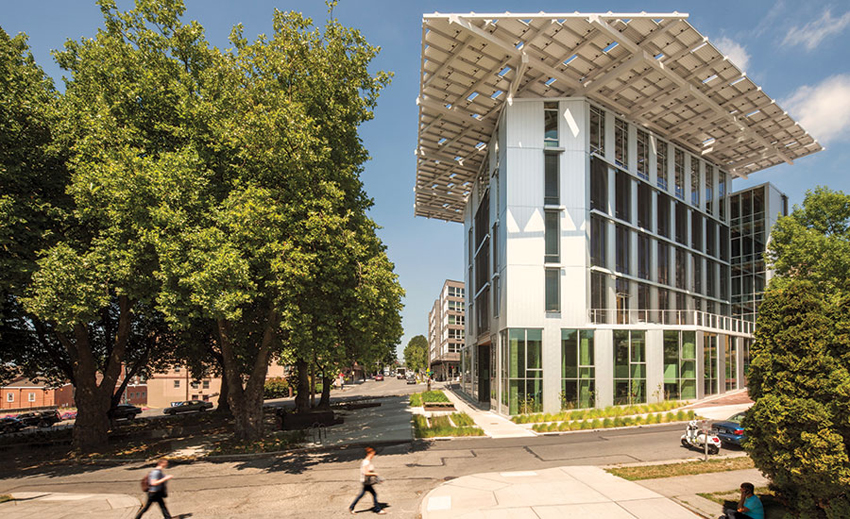
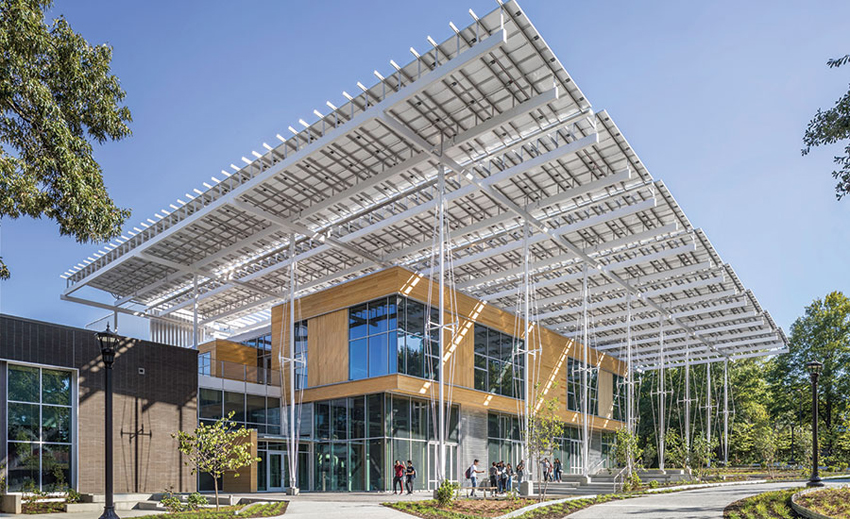
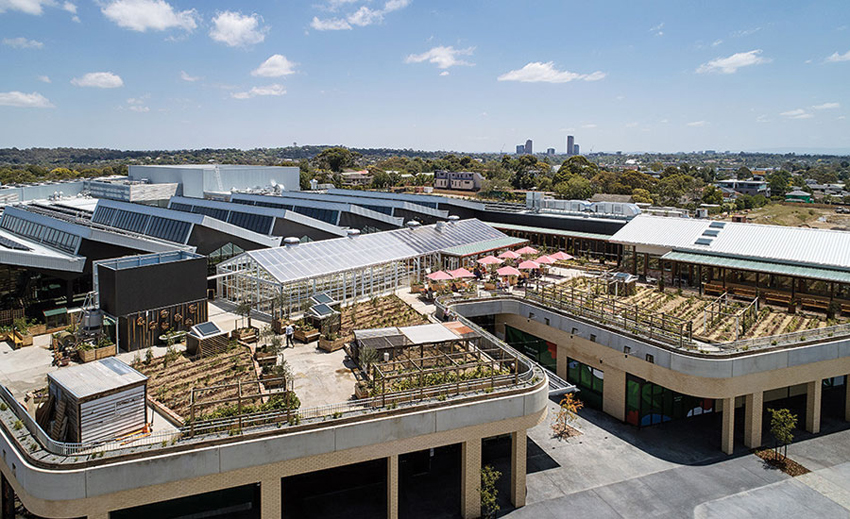
PHOTOGRAPHY: NIC LEHOUX, JONATHAN HILLYER, FRASERS PROPERTY AUSTRALIA
THE BULLITT CENTER, in Seattle (top), and the Kendeda Building, in Atlanta (middle), both by Miller Hull—with Lord Aeck Sargent for Kendeda—meet the LBC net-positive energy requirement with expansive PV arrays. A shopping mall (bottom) in Melbourne, pursuing certification, has a rooftop farm.
View course on architecturalrecord.com »
THE TEXT of the Living Building Challenge (LBC) certification system reads more like a manifesto than a green building standard. The document asks project teams to “imagine a building designed and constructed to function as elegantly and efficiently as a flower.” It implores users to “think about every single act of design and construction as an opportunity to positively impact the greater community of life and the cultural fabric of our human communities.” Extending the flower metaphor, it is organized into seven categories, or “Petals”—Place, Water, Energy, Health + Happiness, Materials, Equity, and Beauty. Jason McLennan, the Challenge’s author, and founder and former CEO of the International Living Future Institute (ILFI), which administers the standard, explains the unusual tone. “The Challenge has always been a philosophy first and an advocacy and certification tool second,” says McLennan, now head of his own Bainbridge Island, Washington, design firm.

PHOTOGRAPHY: © JOE FLETCHER
THE LARGEST project, and the only production facility, to achieve Living status is a 100,000-square-foot winery and tasting room for Silver Oak, in California’s Napa Valley.
The New Age terminology belies LBC’s rigor. The Challenge is widely regarded as the world’s most stringent building-certification tool. Its seven Petals are divided into 20 mandatory “imperatives.” Many are tough to achieve, including avoidance of products that contain substances on a long “Red List” of hazardous chemicals commonplace in building materials. LBC projects are also required to be net positive for both energy and water—and not just on the basis of modeling. Teams must submit at least 12 months’ worth of data demonstrating such performance. The LBC is so difficult, in fact, that only 25 projects have achieved full “Living” status since the launch of its first version in 2006. By and large, these have been small structures, with straightforward programs, such as nature centers. There have been notable exceptions, of course, including the Bullitt Center, in the Capitol Hill neighborhood of Seattle (RECORD, June 2013). Completed in 2013, and certified two years later, the 52,000-square-foot, five-story office building, designed by the Miller Hull Partnership with a projecting roof clad in photovoltaic (PV) cells was, until very recently, the world’s largest Living structure.
Now the scale of Living projects is increasing. Currently, 338 projects are registered with ILFI as aiming for living status, and a number of buildings that are certified, or on the path to certification, are meeting or exceeding the size and complexity of Bullitt. Some have surprising programs. Last April, the vintner Silver Oak, in Healdsburg, California, certified a 100,000-square-foot winery and tasting room housed in buildings designed by Piechota Architecture—making it the largest Living project thus far, and the only production facility to achieve this status. An even bigger project, Brickworks—a 140,000-square-foot shopping mall near Melbourne, designed by NH Architecture—was completed in late 2019. The complex, which includes a 27,000-square-foot rooftop farm, is targeting Living status. Teams are also tackling potential Living projects in difficult climates, such as Atlanta, with its heat and humidity, where the Kendeda Building for Innovative Sustainable Design—designed by Miller Hull and Lord Aeck Sargent—opened on the campus of the Georgia Institute of Technology in the fall of 2019 (RECORD, December 2019). The 37,000-square-foot academic facility, which has completed its performance period and is on track for certification, has an expansive PV trellis that shades the building, collects rainwater, and generates electricity. “The Challenge is no longer a fringe program,” says Chris Hellstern, Miller Hull’s Living Building Challenge services director. Among the firm’s current projects pursuing Living status are an innovation center for the Port of Seattle, and a residence.



PHOTOGRAPHY: NIC LEHOUX, JONATHAN HILLYER, FRASERS PROPERTY AUSTRALIA
THE BULLITT CENTER, in Seattle (top), and the Kendeda Building, in Atlanta (middle), both by Miller Hull—with Lord Aeck Sargent for Kendeda—meet the LBC net-positive energy requirement with expansive PV arrays. A shopping mall (bottom) in Melbourne, pursuing certification, has a rooftop farm.
As the number of projects pursuing LBC, along with the diversity of typologies, has been growing, ILFI has also been expanding its offerings. One example is its Zero Carbon program, launched in 2018. Certification, which typically entails procurement of low-carbon materials, implementation of energy-efficiency measures, and the purchase of environmental offsets, is proving attractive to publicly traded companies with ambitious corporate sustainability goals. Last year, Google, whose climate targets include operating all its data centers and campuses with carbon-free energy by 2030, was the first company to achieve the certification—for 6 Pancras Square, the office building it has leased as its London headquarters since 2016. Similarly, Microsoft, which has an aggressive plan to be carbon negative by 2030, and by 2050 offset all the carbon the 45-year-old company has emitted since its founding, has committed to pursuing Zero Carbon certification for modernization projects at its Silicon Valley and Puget Sound campuses. Meanwhile, Salesforce, the cloud-based software company, is targeting Zero Carbon certification on all its new office spaces.
A sampling of the institute’s other initiatives include “Declare,” an ingredients label for building products; “Just,” a program for companies who want to improve their organizations’ social equity; and a partial, or Petal, certification option, which allows project teams to focus on either water, energy, or materials. One of the newest offerings, introduced in 2019 with Version 4.0 of the LBC, is a Core Green Building Certification alternative. It entails satisfying the requirements for 10 of the 20 LBC imperatives—those deemed essential for a structure to be considered a sustainable building. For instance, the Core program calls for a healthy interior environment, universal access, and deep cuts in energy and water consumption, but not for net-positive performance. Shawn Hesse, the institute’s director of business development, describes these programs as “stepping-stones” and “reporting mechanisms for organizations interested in accountability and a framework for meaningful action.”

IMAGE: COURTESY ZGF
THE PAE BUILDING, under construction Portland, Oregon, faced tough constraints on PV panels due to its location in a historic district.
The growing roster of programs helps catalyze change in architectural practice and the construction industry, says Vivian Loftness, a professor at the School of Architecture at Carnegie Mellon University and an ILFI board member. But full Living status remains the ultimate prize. “It is the pot of gold at the end of the rainbow,” she says. “Let’s keep it there and keep it difficult.”
Kathy Berg, a partner at ZGF in Portland, Oregon, confirms that the LBC is indeed difficult. “Challenge is part of the name for a reason,” she says. Her firm is the architect for a five-story retail and office building under construction in the Skidmore/Old Town historic district of Portland that is aiming for full LBC status. If certified, the 58,000-square-foot building—named after its prime tenant, the engineering firm PAE, the project’s m/e/p consultant—will supplant the Bullitt Center (which PAE also worked on) as the largest privately developed Living office building. In an unusual move, both PAE and ZGF have taken equity in the project in lieu of design fees. (The contractor, Walsh Construction, is also an equity partner.)
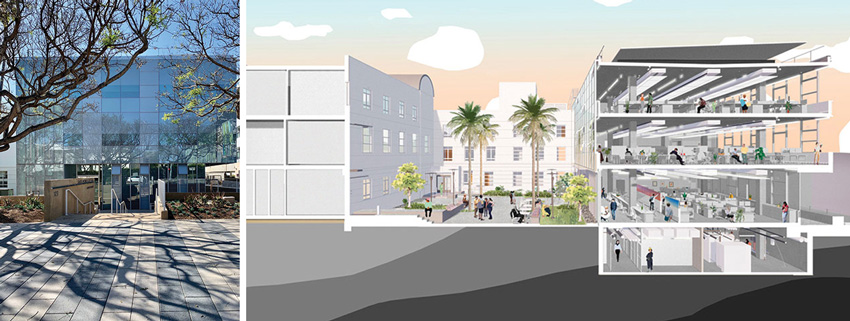

IMAGES: FREDERICK FISHER AND PARTNERS (TOP 2); MILLER HULL PARTNERSHIP ( BOTTOM)
FORWARD-THINKING cities have begun to embrace Living Building, including Santa Monica, where a glass-clad addition (top, left) to City Hall, enclosing a courtyard (top, right), has recently opened, and Seattle, where an innovation center in a historic building at the port (above) is planned.
Wearing the hats of both architect and client gave ZGF’s Berg a new perspective, bringing home the need to maximize rentable area on the tight site. The solution was enhanced seismic performance: inside its brick-clad skin, the PAE Building will have a robust mass-timber frame and a concrete shear-wall core. The structure will sway significantly less than a typical code-compliant one in a major quake, which means that designers can allow less space between it and adjacent structures and therefore increase the size of floor plates. But in order to be cost effective, the structure would need to provide multiple benefits. Its exposed timber and concrete components are designed to provide the conduit for mechanical systems, serve as the primary finishes, and help bounce daylight deep into the interior from the facade’s tall windows. “In a Living Building, every system needs to perform 10 functions,” says Berg.
Ingenuity was also needed to meet LBC’s net-positive-energy mandate. Despite energy-saving features such as air-source heat pumps, radiant heating and cooling, heat recovery, and best-in-class lighting, the PAE Building’s power demand will exceed the capacity of the PVs that will fit on the roof. In addition, the location in a dense urban environment and in a historic district meant that designers could not extend the area for mounting PVs with roof overhangs. To meet demand, the team took advantage of what LBC refers to as “scale jumping,” a concept introduced with Version 1.3 of the certification system, released in 2008. In certain circumstances, it allows projects to go outside their site boundaries in order to satisfy some imperatives. In this case, the developers will install a 130kW PV array on the PAE Building, and have donated a 207kW one for Renaissance Commons, an affordable-housing project in another part of the city. “The arrangement is a win-win,” says Marc Brune, PAE principal. “They get the power, and we get the renewable-energy credits.”
Despite the hurdles, LBC is not only gaining momentum for privately developed projects, but also with public projects in forward-looking cities. One such building pursuing Living certification is a recently completed 50,000-square-foot addition to the Art Deco city hall of Santa Monica, California. Designed by Frederick Fisher and Partners (FF&P), the three-story glass-clad annex consolidates office space that city agencies had previously been renting elsewhere in Santa Monica. LBC is a particularly good fit for the beachfront city, given its environmental goals, which include carbon neutrality by 2050, zero waste by 2030, and a target for water self-sufficiency that is shockingly close—2023, when it plans to stop importing water and rely only on groundwater.
With the aim of staying within a water budget that could be met with the 141⁄2 inches of rain that fall in Santa Monica in a typical year, the $60.8 million project relies on three separate strategies. It has foam-based composting toilets; a system that captures graywater and condensate from the cooling system’s air-handling units for irrigation; and a rainwater-to-potable-water system that collects rainfall from the roof, storing it in a 40,000-gallon cistern. The city hall addition will be the first public building in California in which rainwater comes out of the drinking fountains, according to Joseph Coriaty, FF&P managing partner. The permitting process was involved, he says, since there were few precedents for these systems, and agreement on their design was needed from city, county, and state agencies.
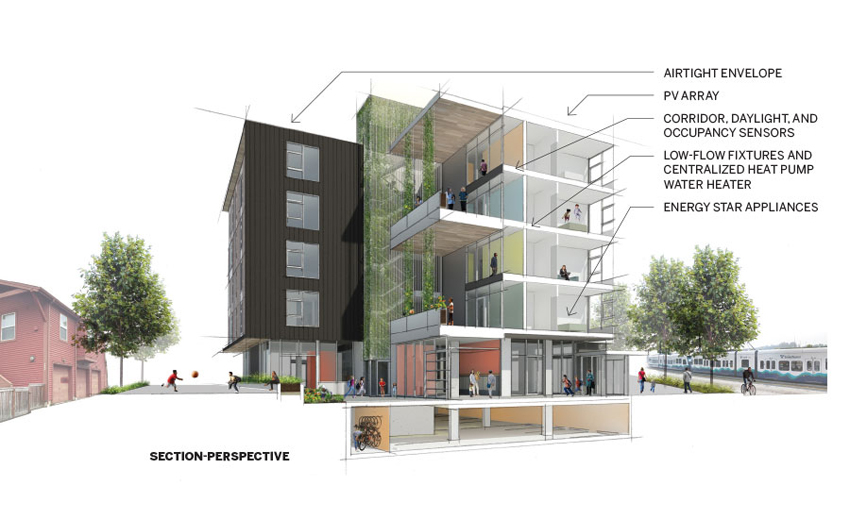
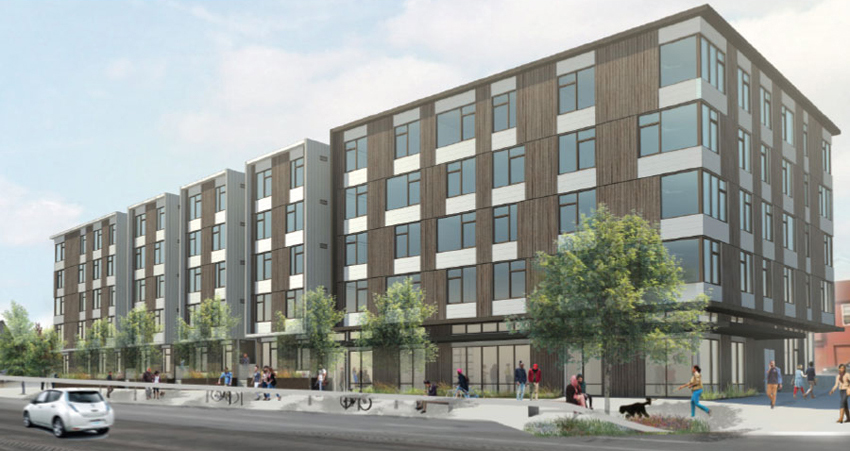
IMAGES: COURTESY SUNDBERG KENNEDY LY-AU YOUNG ARCHITECTS
OTHELLO, a 68-unit affordable cooperative building slated to break ground this spring in Seattle, is pursuing the Materials Petal of the LBC, and will have fiberglass, rather than vinyl, windows.
Although obtaining permissions for the unconventional systems can be labor-intensive, the consensus among sources is that vetting materials for Red List ingredients is the most time-consuming aspect of an LBC project. And for buildings where budgets are exceptionally tight, the obstacles to finding suitable products are compounded. “The affordable-housing sector is really tied to business as usual,” says Gladys Ly-Au Young. Her firm, Sundberg Kennedy Ly-Au Young, is pursuing the Materials Petal for the Othello, a 68-unit affordable cooperative building slated to break ground this spring in Seattle. She notes that, while there are incentives and funding that can help pay for energy-efficiency measures, such as the grant the project received from a local utility for its heat pump hot-water system, there are no equivalent programs for materials.
For Othello, eliminating vinyl (a Red List ingredient omnipresent in products typically used in affordable housing) was particularly vexing—especially when it came to the windows. But, ultimately, the architects were able to find a manufacturer willing to fabricate fiberglass windows during slow periods, thereby allowing them to match the price of vinyl while evening out their production cycles, explains Ly-Au Young.
Shining a light on the roadblocks to creating ultra-green buildings—like those in obtaining healthy materials encountered on Othello, or other impediments, whether they are related to regulations, technology, or economics—is what the LBC is all about, says McLennan. He’s encouraged that barriers are falling, one by one. But he warns that, in order stall global warming, the pace will need to further accelerate. “We are losing the climate battle and destroying habitat and biodiversity,” he says. “The world needs Living Buildings now more than ever.”
Supplemental Material
Living Building Challenge 4.0, International Living Future Institute, June 2019 (Through page 27)






















